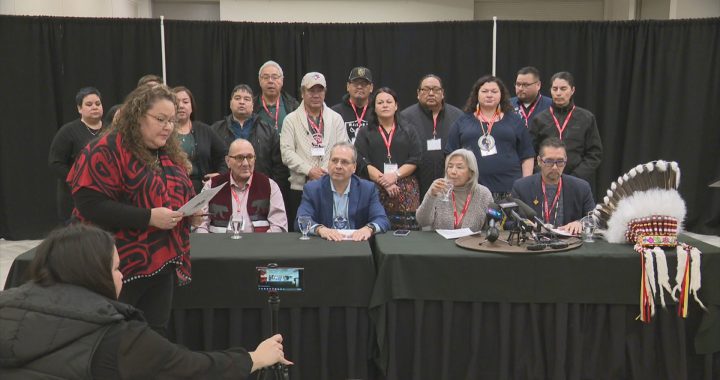Kent Driscoll APTN NewsNunavut is no longer the only place in Canada without a positive test for the COVID-19 virus.Officials in Nunavut confirmed today that a positive test was reported April 29 in Pond Inlet, located 1,067 kilometres northeast of Iqaluit.Premier Joe Savikataaq broke the news to the territory from the floor of the Nunavut Legislative Assembly.”I am confirming that Nunavut’s first case of COVID-19 [is] in Pond Inlet,” said Savikataaq, adding, “No one wants this virus. No one brought this virus to Nunavut on purpose. No one deserves to be shamed or blamed.”Pond Inlet is located on the Northeast tip of Baffin Island, at the beginning of the Northwest Passage.The fly-in community has 1,600 residents has all of the housing challenges of a small Nunavut community.The same overcrowded conditions that allow tuberculous and RSV to thrive in Nunavut could make transmission of COVID-19 easier.Dr. Michael Patterson, Nunavut’s chief public health officer followed through on his promise to identify which Nunavut communities contract the virus.His reasoning is that by naming the community, other communities won’t over react and flood the health centres.But while the community was named, not much was said about the patient, who is said to be doing well in isolation in Pond Inlet.”The individual developed symptoms last week, was swabbed on the 23rd, and to the best of our information has been isolating at home since then,” explained Patterson.”The results came back positive yesterday.”That set off a chain of investigation into where and how the patient caught the virus, and who they may have been in touch with.Close to 20 different Pond Inlet residents are now being tested for COVID-19, due to their potential contamination from the patient.There are also seven other cases in Pond Inlet, unrelated to this positive patient, that are being investigated for the virus.Someone having 20 contacts that need tracing in a community of 1,600, which was supposed to be following social distancing guidelines, may sound like a lot, but according to Patterson, that beats national numbers.”The number of contacts we’ve identified is low compared to what I’ve heard about from other jurisdictions,” he said.A public health emergency response team was dispatched from Iqaluit Thursday with three public health nurses and an assistant to manage equipment. They won’t be providing primary care, their job is the detective work of seeing just how far the virus has been spread.A travel ban has been placed on Pond Inlet, the only people now allowed to fly in or out of the community are health workers and other essential personnel. Cargo and mail for the fly-in community will continue.”All passenger travel in and out of Pond Inlet should cease,” said Patterson. “This includes any movement in and out of the community by land travel.”Although Pond Inlet is a fly-in community, visitors on snowmobiles from relatively nearby Arctic Bay and Igloolik are common.All non-essential offices and businesses will now be closed.The two grocery stores in the community are enforcing social distancing by only allowing 10 customers in at any given time. The health centre is asking people to call before they show up, to better manage the caseload.Until now, tests that have been taken in Nunavut were processed in Winnipeg.Tests could take seven days to be completed but now, Nunavut’s health department is using a machine in Iqaluit – that they usually use to test for tuberculosis – to test for COVID-19, leading to a same day turnaround for emergency tests.They are still calibrating the machine and have a very limited amount of replacement cartridges, so all the instant tests processed in Iqaluit will be duplicated in an Ontario lab.Results for the tests from the 20 people the patient may have been in close contact with are expected by May 1.“We have some capacity for testing that we were reserving for high risk situations,” said Patterson. “This is a situation where knowing right away, getting information quickly, is obviously very important.”Washing your hands is a proven prevention for COVID-19, but Pond Inlet has been having water problems all winter. A key pipe froze and will not be thawed until spring, so water trucks have been forced to park on the ice and drill a new water hole every morning.All of Pond Inlet’s water is delivered by truck.The premier confirmed there is help on the way, a pump so that the trucks can stay off the ice, and fill up faster. A more permanent fix will be applied in the spring.”CGS [Department of Community and Government Services] will be flying up a pump there,” explained Savikataaq. The situation isn’t ideal, the temporary pump will have to be removed every night and returned in the morning.COVID-19 arriving in Nunavut was bound to happen eventually. The travel and gathering restrictions placed by the Health department were designed to slow the arrival and spread.The hope was -by the time the virus hit Nunavut, the rest of the country would be in a better place to help the territory deal with it. Slowing transmission also lowers the chance of multiple Nunavut communities having Covid-19 outbreaks at the same time.”We anticipated that sooner or later the virus would be detected in the territory,” explained Patterson.”Just as we poured extensive effort into our prevention plan, so to have we developed a comprehensive response plan to minimize the impact COVID-19 has on Nunavut.”










